Article Number: DH3-014
Last Updated: June 19th, 2025
This article provides instructions on how to configure a multi-display setup on AMD Radeon™ RX Series Graphics to run in Eyefinity mode with AMD Software: Adrenalin Edition.
Overview
AMD Eyefinity is a technology that allows combining two or more displays to produce a single large surface desktop. The display resolution and screen area of the single large surface desktop are determined by the number of displays and how they are arranged in the Eyefinity group. For example: Three 1920x1080 displays arranged in 3x1 AMD Eyefinity mode, will produce a horizontal desktop with a combined resolution of 5760x1080.
AMD Eyefinity is supported on Microsoft Windows® 10 and Windows® 11 based desktop systems equipped with AMD Radeon™ Series Graphics. A single Eyefinity group, with up to six displays, can be created per graphics card. The number of displays supported is determined by the specifications of the graphics card.
Note: The steps outlined below are based on AMD Software: Adrenalin Edition 25.6.1 (Default Install) with an AMD Radeon™ RX 9070, and the screenshots used are for illustrative purposes only. Depending on your system configuration, some options and settings may not be available to you or exactly as shown in the examples provided.
Quick Setup
To create an Eyefinity display group, multi-display (in extended mode) must be enabled via Windows Display settings. For help setting up multi-display, refer to these Microsoft® articles:
With multi-display extend mode enabled, to create an Eyefinity display group with AMD Software: Adrenalin Edition, follow these steps:
- From the Taskbar, click the Start button (Windows icon), type AMD Software and select the app under best match.
- In AMD Software, enter "Display" into the search box (highlighted below), and click on the "Display Settings" result displayed.

- In the Eyefinity section, click on Quick Setup next to the AMD Eyefinity tile.
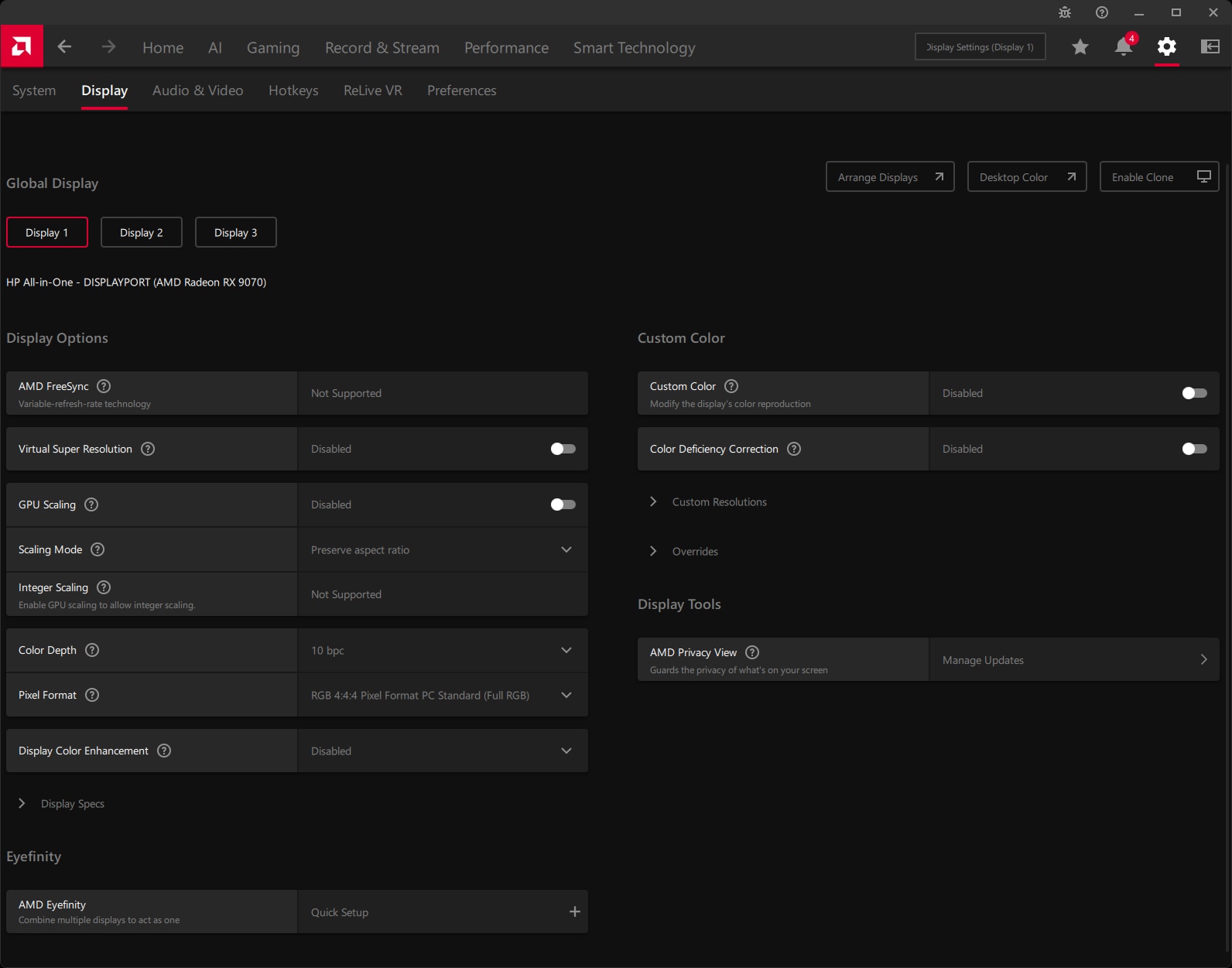
- Quick Setup will automatically apply the display arrangement from Windows, Display settings to the new Eyefinity group. If the display arrangement is correct the setup is complete. However, if the displays in the newly created Eyefinity group are not arranged in the correct order, they can be adjusted using the Display Arrangement option.
- To rearrange the position of displays in the Eyefinity group, select Display Arrangement, and then click Rearrange Displays (as shown below). Note: If the Display Arrangement option is not available, click Discard Setup next to the AMD Eyefinity tile and recreate the Eyefinity display group using Quick Setup.
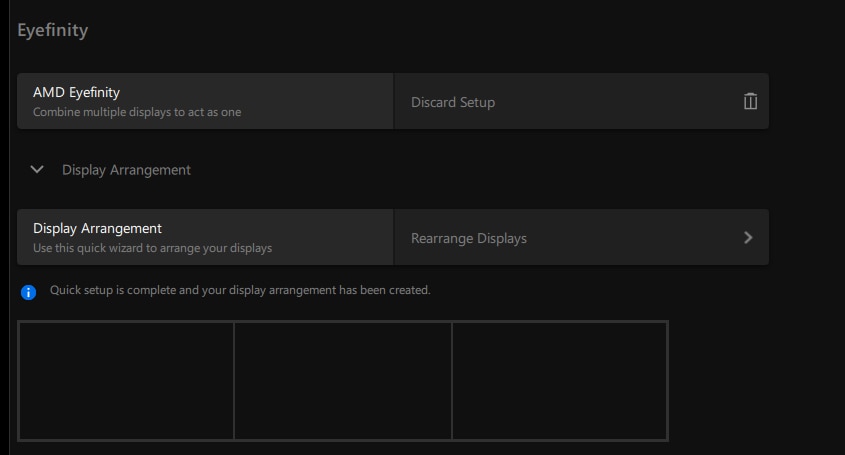
- A blue screen will show on one of the displays, for example:

- Click on the matching box to confirm the position for the blue screen display. Using the above example, click the left box (indicated in the picture below).

- After confirming the first display, the blue screen will show on a second display, for example:

- Click on the matching box to confirm the position for the blue screen display. Using the above example, click the middle box (indicated in the picture below) and the last display position will be applied automatically.

- The display arrangement for the Eyefinity group in the above example is now complete. If there are more than three displays in your Eyefinity group, continue the process until completion.
Preferred Display
Some applications and games may not be optimized for AMD Eyefinity or fully support the Eyefinity display group resolution. This can be rectified by setting a preferred display with AMD Software which will allow the application/game to run only on the desired display in the Eyefinity group.
To set your preferred display, follow these steps:
- Under Global Display, click on the desired display. In this example, the middle display (Display 2), was selected.
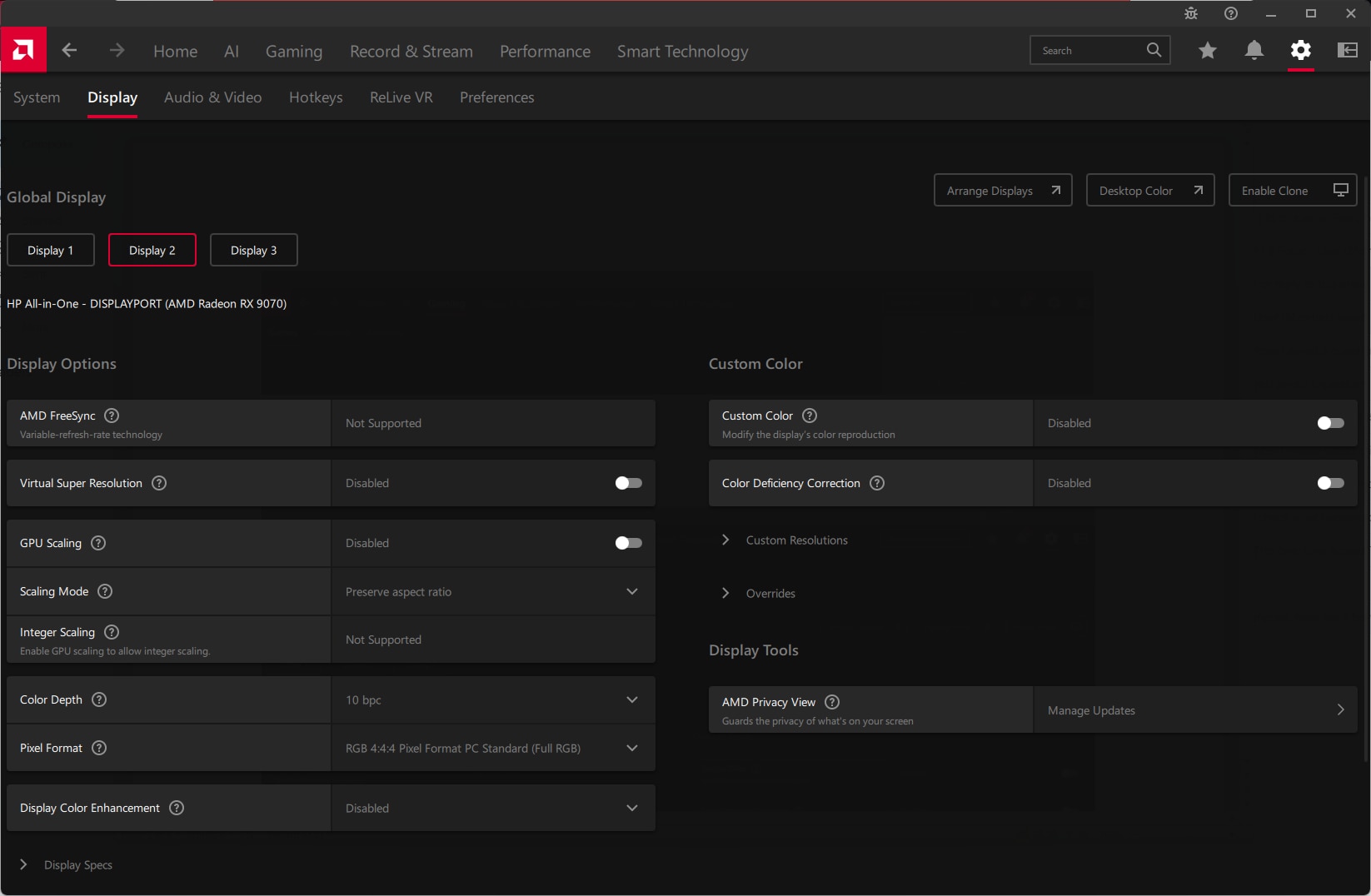
- Locate the Preferred Display option near the bottom and toggle the switch to Enabled. Note: The Preferred Display option is available only when AMD Eyefinity mode is active.

- Display 2 is now set as the preferred display. Applications and games that are not optimized for AMD Eyefinity mode will only show on Display 2.

- To change the preferred display, repeat the steps above.
Launch with AMD Eyefinity
With AMD Eyefinity mode enabled, any games that support Eyefinity resolutions will launch using all displays in the Eyefinity group as one combined display. However, depending on current system use and running applications, using multi-displays with extended mode enabled may be preferred over Eyefinity. In such cases, switching to Eyefinity mode for gaming would not require going through the Quick Setup process again. If the display arrangement in extended mode is correct, a game can be launched in Eyefinity mode, and the displays will automatically revert to extended mode after exiting the game. This can be achieved with the application profile feature built into AMD Software. For information on how to create an application profile, refer to article: Customize Graphics Settings with AMD Software: Adrenalin Edition
To setup a game to launch in Eyefinity mode, follow these steps:
- In AMD Software, enter "Game" into the search box and click on the "Gaming" result displayed.
- Select the desired the game by clicking on its tile.
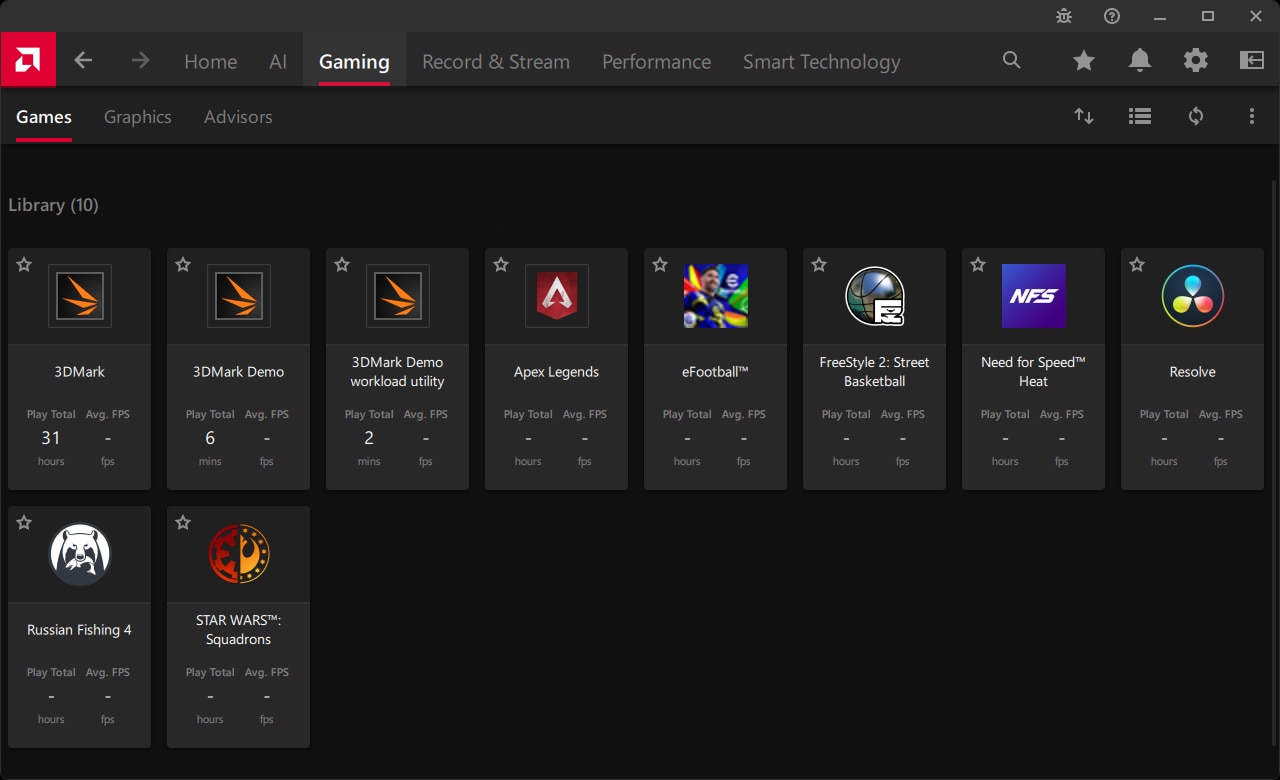
- Locate Launch with AMD Eyefinity and toggle the option to Enabled. The application profile for STAR WARS™: Squadrons was used in the example below.
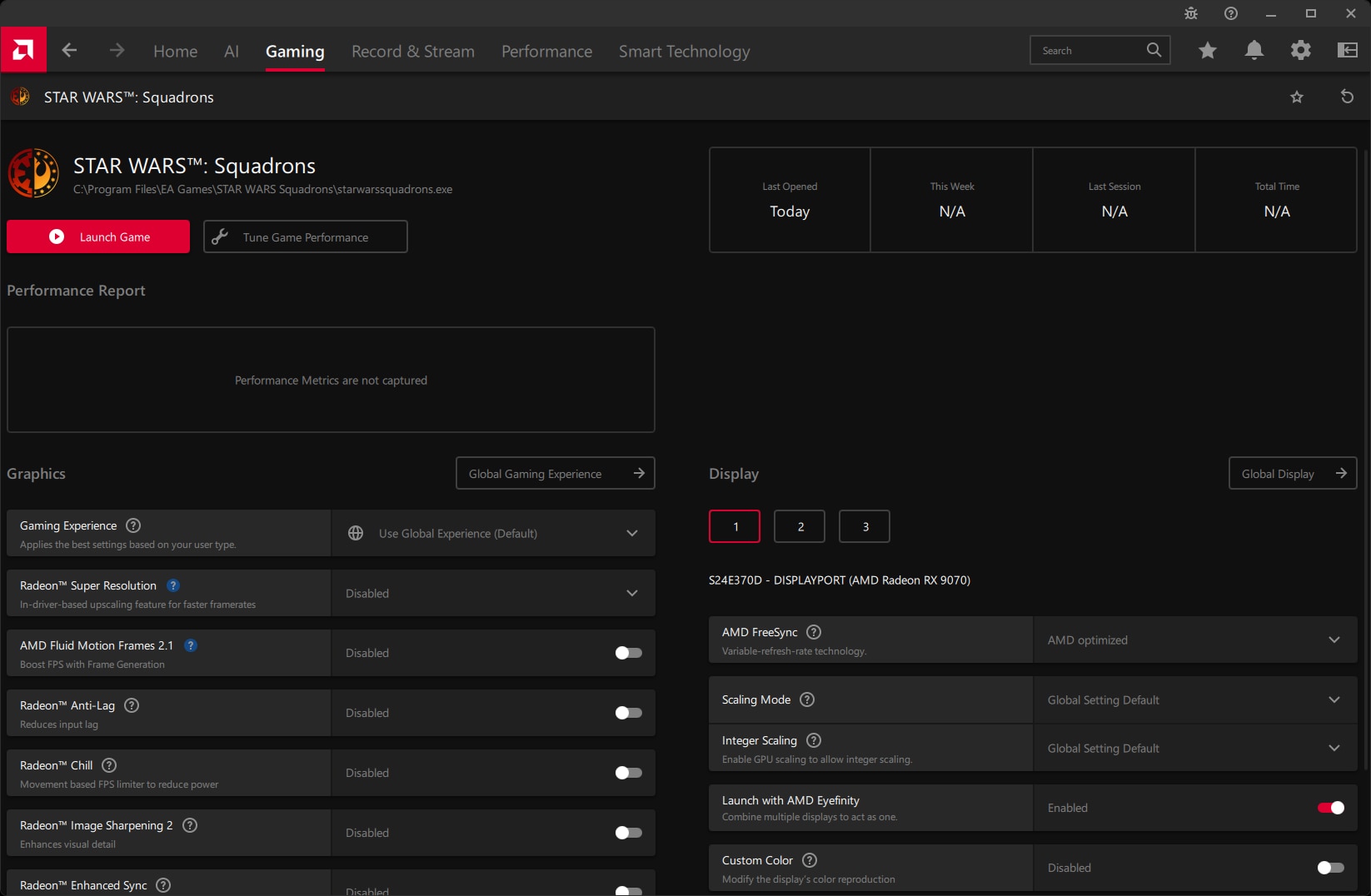
- Once enabled, STAR WARS™: Squadrons can be launched by any method (AMD Software, game launcher, shortcut icon, etc.) and should automatically run in Eyefinity mode.

© 2025 Advanced Micro Devices, Inc. All Rights Reserved.
DISCLAIMER
The information contained herein is for informational purposes only and is subject to change without notice. While every precaution has been taken in the preparation of this document, it may contain technical inaccuracies, omissions and typographical errors, and AMD is under no obligation to update or otherwise correct this information. Advanced Micro Devices, Inc. makes no representations or warranties with respect to the accuracy or completeness of the contents of this document and assumes no liability of any kind, including the implied warranties of non-infringement, merchantability or fitness for particular purposes, with respect to the operation or use of AMD hardware, software or other products described herein. No license, including implied or arising by estoppel, to any intellectual property rights is granted by this document. This notice does not change the terms and limitations applicable to the purchase or use of AMD's products that may be set forth in a separate signed agreement between you and AMD.
OVERCLOCKING WARNING: AMD processors are intended to be operated only within their associated specifications and factory settings. Operating your AMD processor outside of official AMD specifications or outside of factory settings, including but not limited to the conducting of overclocking (including use of this overclocking software, even if such software has been directly or indirectly provided by AMD or otherwise affiliated in any way with AMD), may damage your processor and/or lead to other problems, including but not limited to, damage to your system components (including your motherboard and components thereon (e.g. memory)), system instabilities (e.g. data loss and corrupted images), reduction in system performance, shortened processor, system component and/or system life and in extreme cases, total system failure. AMD does not provide support or service for issues or damages related to use of an AMD processor outside of official AMD specifications or outside of factory settings. You may also not receive support or service from your board or system manufacturer. Please make sure you have saved all important data before using this overclocking software. DAMAGES CAUSED BY USE OF YOUR AMD PROCESSOR OUTSIDE OF OFFICIAL AMD SPECIFICATIONS OR OUTSIDE OF FACTORY SETTINGS ARE NOT COVERED UNDER ANY AMD PRODUCT WARRANTY AND MAY NOT BE COVERED BY YOUR BOARD OR SYSTEM MANUFACTURER’S WARRANTY.
The software that has been directly or indirectly provided by AMD or an entity otherwise affiliated with AMD may disable or alter: (1) software including features and functions in the operating system, drivers and applications, and other system settings; and (2) system services. WHEN THE SOFTWARE IS USED TO DISABLE OR ALTER THESE ITEMS IN WHOLE OR PART, YOU MAY EXPERIENCE (A) INCREASED RISKS THAT CERTAIN SECURITY FUNCTIONS DO NOT FUNCTION THEREBY EXPOSING YOUR COMPUTER SYSTEM TO POTENTIAL SECURITY THREATS INCLUDING, WITHOUT LIMITATION, HARM FROM VIRUSES, WORMS AND OTHER HARMFUL SOFTWARE; (B) PERFORMANCE AND INTEROPERABILITY ISSUES THAT MAY ADVERSELY AFFECT YOUR EXPERIENCE AND THE STABILITY OF YOUR COMPUTING SYSTEM; AND (C) OTHER EXPERIENCES RESULTING IN ADVERSE EFFECTS, INCLUDING, BUT NOT LIMITED, TO DATA CORRUPTION OR LOSS.
AMD, the AMD Arrow logo, AMD Radeon, AMD Freesync and combinations thereof are trademarks of Advanced Micro Devices, Inc.
Windows and DirectX are registered trademarks of Microsoft Corporation.
Vulkan and the Vulkan logo are registered trademarks of the Khronos Group Inc.
Other names used herein are for identification purposes only and may be trademarks of their respective companies.